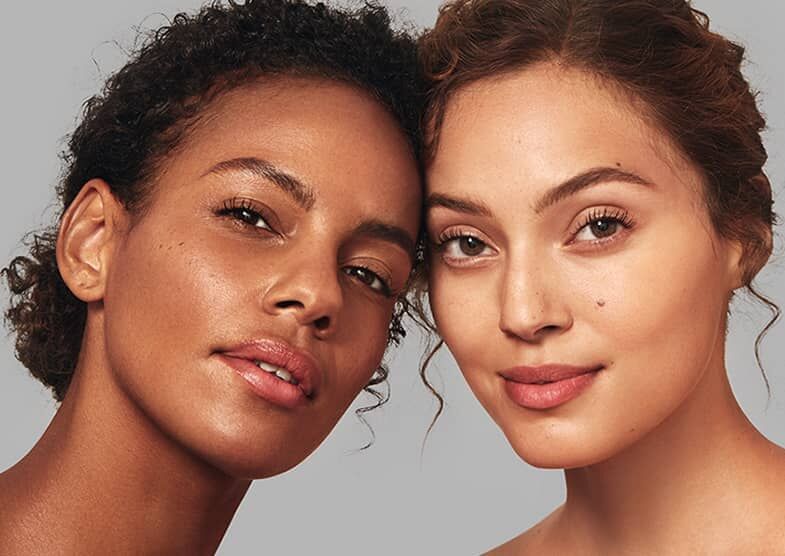What is Glycolic Acid?
A widely used exfoliating ingredient found in a variety of skincare cleansers, moisturizers, scrubs, and masks. Glycolic Acid, an alpha hydroxy acid derived from sugar cane, works by loosening and removing old, dead skin cells revealing the soft, smooth skin beneath. One of several fruit acids with skincare benefits, Glycolic Acid is the most widely used, in part due to its small molecular size, which allows it to easily penetrate the outer layer of the skin without damaging or irritating the skin.
AHA vs BHA
There is another group of hydroxy acids called beta hydroxy acids (BHA). Both AHA's and BHA's are great for exfoliating dead skin cells, reducing inflammation, improving skin texture and tone, and unclogging pores.
| AHAs | BHAs | |
|---|---|---|
| Absorption |
Water-SolublePenetrate the outermost layer of skin |
Oil-SolubleAbsorb into deeper levels of the skin |
| Targets |
Surface Level Concerns:
|
Deep Skin Concerns:
|
| Good For |
Dry Skin Types |
Oily or Combination Skin Types |

AHA Myths, Debunked
Myths

Glycolic Acid Is Drying
When used properly, Glycolic Acid exfoliates only as much as is needed. Plus, Glycolic Acid promotes production of skin-hydrating hyaluronic acid.

Glycolic Acid Is Irritating
When you first start using Glycolic Acid it's possible to overdo it and cause irritation by choosing a concentration that is too high or by applying too frequently. Instead, start slowly with a low concentration and gradually increase.

Glycolic Acid Causes Permanent Thinning of the Skin
Glycolic Acid initially thins your skin by removing the excess buildup of cells, then the exfoliation process promotes new cell growth and collagen formation, producing fuller, healthier skin.
Facts

Glycolic Acid Promotes Cellular Turnover
Glycolic Acid prevents ingrown hairs by exfoliating and promoting rapid cell turnover.

Glycolic Acid Reduces The Appearance of Pores
Glycolic Acid makes large pores appear smaller by removing buildup of dead skin cells.

Glycolic Acid Combats Discoloration
Glycolic Acid evens skin tone and reduces the appearance of hyperpigmentation caused by sun exposure.
Top 5 Reasons
Glycolic Acid Should Be a Staple in Your Skin Care Regimen
Immediate Results and Better Absorption of Treatments
Glycolic Acid's exfoliating action produces noticeable results with each use. And with the old cells gone the skin can better absorb the active ingredients in skincare products and start each day with a fresh, radiant glow.
Youthful Skin: Reduces Fine Lines & Wrinkles
Regular use of Glycolic Acid ensures that the outermost layer of cells is removed before they build up. This gives skin a smoother texture and reduces the appearance of fine lines, wrinkles, and surface scarring. Regular exfoliation also promotes collagen formation and moisture retention, resulting in plumper, healthier skin.
Less Acne Symptoms
Glycolic Acid is proven to significantly reduce acne through its anti-inflammatory and antibacterial activity. Additionally, its moisturizing effects prevent over-drying skin, which occurs with other types of acne medications and can cause the skin to overproduce oils.
Suitable for All Skin Types
Whether your skin is young or not-so-young, or if it's normal, dry or oily, or a combination, you can safely use and benefit from Glycolic Acid.
Can be Used on Your Whole Body
Not only can Glycolic Acid give you a great complexion it can help improve skin health and appearance all around. You can use Glycolic Acid for acne on the chest or back, rough dry skin on elbows and heels, and even keratosis pilaris, those dry, goosebump-like patches that typically appear on the upper arms.
Power Duos:
How to Use It?
Combining skincare ingredients can significantly improve the overall performance and effectiveness of any skincare routine and Glycolic Acid works well with a number of other ingredients. The key to success is to learn how your skin responds to each ingredient and use products according to their directions in order to maximize benefits and avoid irritation.
Works Well With

Hyaluronic Acid
Provides immediate hydration that fends off any temporary dryness or tightness that may occur following Glycolic Acid application and enhances Glycolic Acid's longer lasting moisture-promoting effects for optimal hydration benefits.

Retinol
When used in the right proportions, a small amount of retinol complements Glycolic Acid's surface level benefits by absorbing into the skin's deeper layers, where it works to improve skin health and reduce acne scarring.

Salicylic Acid
The BHA counterpart to Glycolic Acid; the combination of Salicylic Acid with Glycolic Acid can help with a variety of chronic skin conditions. This comprehensive approach has been shown to improve acne, decrease oiliness, and improve skin texture. Washing multiple times per day can clear up acne.

Phytic Acid
Provides antioxidant benefits that, along with the antioxidant effects of Glycolic Acid can reduce hyperpigmentation and give the skin a more luminous appearance.

Niacinamide
Adds anti-inflammatory and skin brightening benefits that complement those of Glycolic Acid.
Don't Use With

Abrasives or Chemicals
Avoid using Glycolic Acid with other types of chemical exfoliants, such as AHA or Retinoid.

Vitamin C
Combine Glycolic Acid carefully with ingredients that alter the skin's pH, such as Vitamin C, which can result in excessively low pH, leading to skin burn.

When to Talk to
Your Dermatologist
- You have never used Glycolic Acid
- You have sensitive skin
- You are no longer seeing results
- Your skin becomes irritated after using Glycolic Acid
